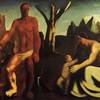Google Celebrates Maria Montessori’s 142nd Birthday
She was the first woman to practice medicine in Italy and her educational method is now followed everywhere in the world. Successful graduates from her alternative schools are many of the world’s most important innovators and personalities, such as Google founders Larry Page and Sergey Brin, video game pioneer Will Wright (the creator of The Sims), Wikipedia founder Jimmy Wales, Amazon CEO Jeff Bezos, writer Gabriel Garcia Marquez, chef Julia Child, and even rapper P. Diddy.
Maria Montessori would have turned 142 on Friday, and Google celebrated this special anniversary with a themed homepage Doodle featuring some of the basic toys and tools the Montessori educational method uses to create child-friendly, grade-free and hands-on learning environments, regardless of age differences among the pupils.
In multiple occasions, Brin and Page directly credited the Montessori method for their success: “I think it was part of that training of not following rules and orders and being self-motivated, questioning what's going on in the world, doing things a bit different,” Page stated in an interview with ABC.
Montessori was born in Chiaravalle, Italy, in 1870. From a very early age she developed an interest in science and graduated from the a technical high school, a very uncommon choice for girls at the time. In 1890 she applied to the medical program at La Sapienza University in Rome, but was denied entrance because of her gender. She then enrolled in the physics and natural sciences program, and was eventually allowed in the medical concentration. In 1986 she defended her dissertation to an all-male examining commission and went on to graduate and become the first woman MD in Italian history.
After gaining on-field experience in insane asylums helping mentally challenged children, in 1904 she began working to her revolutionary educational method. In 1906 she founded a “Children’s House” in the San Lorenzo neighborhood in Rome for the children of disadvantaged households. Her strongest belief was that children have an inner drive to learn and that this potential can be expressed at its best in safe environments where they can experiment freely with objects and educational tools, creating and benefiting from the company of other kids.
“Discipline must come through liberty,” Montessori wrote in Chapter V of her essay The Montessori Method. “We do not consider an individual disciplined only when he has been rendered as artificially silent as a mute and as immovable as a paralytic. He is an individual annihilated, not disciplined. We call an individual disciplined when he is master of himself.”
Her method quickly gained international success. As early as in 1913, Montessori visited the US where in that very year Alexander Graham Bell and his wife Mabel founded the Montessori Educational Association in Washington D.C.
In the 1930s, while Italy was under the Fascist regime, many of the Montessori schools the Italian government had previously sustained were shut down when Montessori herself opposed Mussolini’s order to have the kids wearing fascist uniforms and giving the fascist salute.
However, the international success of the method brought Montessori to travel all over the world. In 1929, the Association Montessori International was founded in Amsterdam, Netherlands. In 1938 a Montessori Training Center in Laren, Netherlands, was opened. Nine years later another Montessori Center was opened in London.
Montessori, who was nominated for the Nobel Peace Prize in 1949, 1950, and 1951, died in Noordwijk, Netherlands, in 1952. More than 20,000 schools around the world today are named after her and embrace her educational method.







































i-Italy
Facebook
Google+
This work may not be reproduced, in whole or in part, without prior written permission.
Questo lavoro non può essere riprodotto, in tutto o in parte, senza permesso scritto.